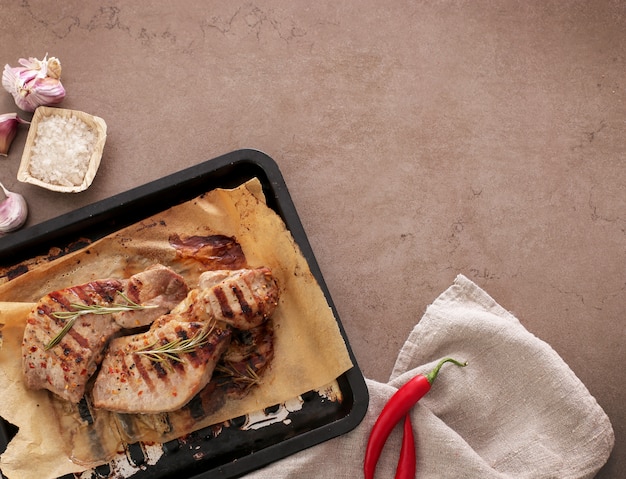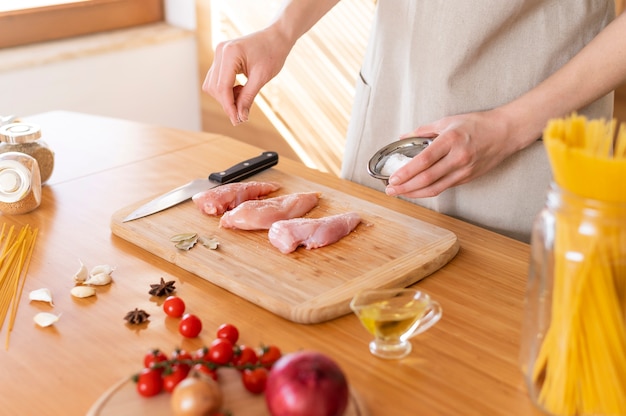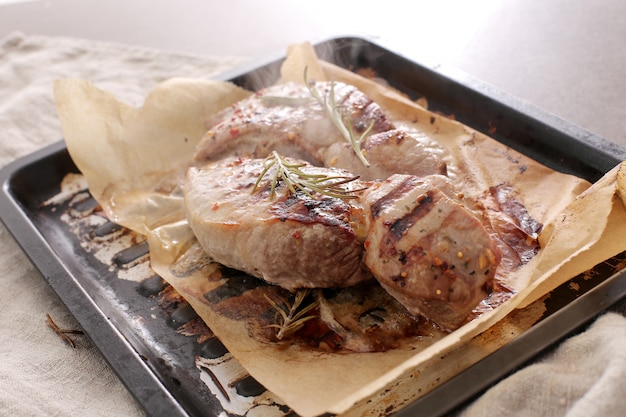Let's face it, there's something undeniably satisfying about a perfectly roasted pork fillet. It's a dish that always impresses, whether it's a weeknight dinner or a special occasion gathering. But let's be honest, getting that tender, juicy, and perfectly cooked pork fillet can feel like a culinary gamble. You've got those horror stories of dry, overcooked meat, and then there's the fear of undercooked pink. I've been there, trust me! Over the years, I've learned a thing or two about mastering the art of oven-roasting pork fillet, and I'm here to share my secrets with you. Let's embark on this journey together, and I promise, you'll be a pork-roasting pro in no time.
(Part 1) Choosing the Right Pork Fillet

The first step to a sensational pork fillet is selecting the right piece of meat. It's like choosing the right canvas for a masterpiece – the quality of your starting point makes all the difference.
The Cut: A Tale of Fat and Texture
When it comes to pork fillets, the ideal cut is one with a good amount of fat marbling running throughout. It's those little pockets of fat that keep the meat incredibly moist and tender during cooking. Imagine it as nature's built-in flavour booster! Look for a fillet that's nicely shaped, without any weird lumps or bumps. If you can, ask your butcher for a trimmed piece – it saves you some prep time and gives you a beautiful, even surface to work with.
Size Matters: Matching Your Fillet to Your Needs
Now, let's talk size. A smaller pork fillet, say 300-400g, will cook much faster than a hefty 600g beast. Think about how much you're serving, and choose a fillet that's the perfect size for your family or guests. No need to overbuy – you don't want to be stuck with mountains of leftover pork! And if you're planning on a large gathering, remember, you can always cook multiple fillets. No worries, it's a win-win for everyone.
(Part 2) Preparing Your Pork Fillet for the Oven

Okay, you've got your perfect pork fillet – now it's time to give it a little TLC before it hits the oven. These simple prep steps will make a huge difference in both the flavour and texture of your finished dish.
Seasoning: A Symphony of Flavours
Don't be shy with the seasoning! We want to give our pork fillet a generous rub with salt and pepper. Remember, you can always add more seasoning after cooking, but you can't take any away! I like to add a pinch of dried rosemary, thyme, and a little garlic powder for that extra layer of flavour. Feel free to experiment with your favourite herbs and spices. I've even been known to add a touch of paprika or smoked paprika for a smoky kick. Let your creativity shine!
Fat It Up: The Secret to Tenderness
This is where we get into a bit of a personal preference. I firmly believe that adding a layer of fat to the pork fillet before cooking is essential for achieving the ultimate juicy, tender result. It's like giving your pork a little hug of flavour and protection. You can use bacon rashers, streaky bacon, or even a good layer of butter. I've even experimented with a thin layer of prosciutto for a slightly salty and delicious touch. Experiment and find what works best for you!
(Part 3) The Oven Game: Temperature and Timing

We're about to enter the heart of the roasting process, where temperature and timing are everything. It's a bit of a science, but don't worry, I'll guide you through every step.
Temperature is Key: Finding the Sweet Spot
Most recipes suggest cooking pork at 180 degrees Celcius (350 degrees fahrenheit), but I've discovered that a slightly lower temperature is ideal for achieving even cooking without drying out the meat. I prefer to roast my pork fillets at 160 degrees Celcius (320 degrees Fahrenheit). It might take a bit longer, but trust me, the results are worth it. It's like slow dancing your way to culinary perfection!
Cooking Time: Navigating the Time Labyrinth
This is the part that often leaves people a bit confused. The cooking time for a pork fillet can vary depending on its size and how well-done you like it. Here's a general guide to help you find your way through the time labyrinth:
| Weight (g) | Cooking Time (Minutes) |
|---|---|
| 300-400 | 20-25 |
| 400-500 | 25-30 |
| 500-600 | 30-35 |
| 600-700 | 35-40 |
Remember, this is just a guideline. The best way to ensure perfect doneness is to use a meat thermometer.
Checking for Doneness: The Thermometer's Tale
Just because your pork fillet has been in the oven for the recommended time, it doesn't mean it's ready to party! We need to check for doneness, and the best way to do that is with a trusty meat thermometer. Pork should be cooked to an internal temperature of 63 degrees Celcius (145 degrees Fahrenheit). No thermometer? Don't fret! You can also check the doneness by poking the pork with a sharp knife. If the juices run clear, it's cooked. If they're still pink, it needs a little more time in the oven.
(Part 4) Resting is Key: Letting the Juices Redistribute
We're almost at the finish line! But before you dive into slicing and serving, it's crucial to let your pork fillet rest for at least 10-15 minutes. I know it's hard to resist, but this is essential for creating the ultimate juicy and tender result. While the pork is resting, the juices will redistribute throughout the meat, ensuring that every bite is bursting with flavour. Think of it as a little culinary spa treatment for your pork.
(Part 5) Serving Your Pork Fillet: A Symphony of Flavours
The moment you've been waiting for – your perfectly cooked and rested pork fillet is ready to be served. Now, it's time to unleash your culinary creativity and create a symphony of flavours.
The Classic Approach: A Timeless Tradition
For a truly satisfying classic roast, slice the pork fillet and serve it with roast potatoes, crisp vegetables, and a rich, savoury gravy. It's a timeless combination that never fails to please. The warm, comforting flavours of the roast potatoes, the vibrant freshness of the vegetables, and the rich, velvety gravy create a harmonious dance on your palate. It's a classic for a reason, and always a winner.
Thinking Outside the Box: Exploring New Horizons
But if you're looking to step outside the traditional, think about how you can elevate your pork fillet to new heights. Experiment with different flavours and ingredients to create exciting and memorable dishes.
- Asian-Inspired: Think stir-fried vegetables, rice, and a tangy sauce. The combination of sweet and savoury flavours adds a unique dimension to the classic pork fillet.
- Mediterranean Delight: Grilled peppers, olives, feta cheese, and a drizzle of olive oil bring a taste of the Mediterranean to your table. The vibrant colours and flavours create a visually appealing and flavourful dish.
- South American Fusion: Get adventurous with a salsa verde, grilled pineapple, and a sprinkle of fresh cilantro. It's a bold and exciting combination that will transport your taste buds to a sunny beach in South America.
(Part 6) Leftovers: Don't Waste Them, Transform Them!
Let's face it, sometimes you end up with a bit of leftover pork fillet. Don't throw it away! Leftovers are a golden opportunity to create delicious and satisfying meals.
The Classic Sandwich: A Quick and Easy Win
A simple pork fillet sandwich is always a crowd-pleaser. Slice the leftover pork, add a generous helping of your favourite salad ingredients, and you've got a tasty lunch or supper.
Get Creative: Beyond the Ordinary
But if you're feeling a little more adventurous, get creative with your leftovers! Chop up the pork and add it to pasta dishes, stir-fries, or salads. It's a great way to add protein and flavour to your meals.
- Pasta Perfection: Toss the leftover pork with a creamy alfredo sauce or a spicy tomato-based sauce, and serve it over your favourite pasta. It's a simple yet delicious way to use up leftovers.
- Stir-Fry Fiesta: Chop up the leftover pork and add it to a stir-fry with your favourite vegetables and a flavorful sauce. It's a quick and easy weeknight meal that's packed with flavour.
- Salad Superstar: Add the leftover pork to a bed of mixed greens, some chopped vegetables, a sprinkle of cheese, and a light vinaigrette. It's a healthy and refreshing meal that's perfect for a warm summer day.
(Part 7) Pork Fillet Mistakes to Avoid: Learning From Experience
We've all been there, haven't we? Those moments when you think you've nailed the perfect pork fillet, only to be met with disappointment. Dry, tough, or just not quite right – those are the culinary nightmares we want to avoid. Here are a few common mistakes to watch out for, so you can avoid those disappointing experiences and achieve pork fillet perfection.
Overcooking: The Enemy of Juiciness
This is the most common mistake, and it's a real shame. overcooked pork fillet is dry, tough, and frankly, not very enjoyable. To avoid this, remember to check the internal temperature with a meat thermometer. If you don't have a thermometer, rely on the knife test. If the juices are still pink, it needs a little more time in the oven.
Not Resting: Letting the Juices Escape
I know I've already emphasized this, but it's worth repeating! Not letting your pork fillet rest is a surefire way to lose precious juices. The result? Dry and disappointing meat. Remember, those 10-15 minutes of rest are essential for juicy, flavorful pork.
Not Seasoning Enough: Don't Be Shy
It's always better to err on the side of generous seasoning. You can always add more flavour after cooking, but you can't take any away. So, don't be afraid to use a good amount of salt, pepper, and your favourite herbs and spices. Let your culinary imagination run wild!
(Part 8) FAQs: Your Burning Questions Answered
I've covered a lot of ground, but I know you might still have some lingering questions. Here are some of the most frequently asked questions, along with detailed answers to help you conquer your pork fillet cooking quest.
Q: Can I cook my pork fillet from frozen?
A: It's technically possible, but I strongly recommend against it. Frozen pork fillet will take much longer to cook evenly, and you're more likely to end up with dry, tough meat. It's always best to cook your pork fillet from fresh. It's like starting with a blank canvas, ready to be transformed into a culinary masterpiece.
Q: What are some good side dishes to serve with pork fillet?
A: The classic choice is roast potatoes, vegetables, and gravy. But there's a whole world of possibilities! Here are a few ideas to inspire you:
- mashed potatoes: Creamy and comforting, they're a perfect pairing for the rich flavour of pork fillet.
- cauliflower cheese: A cheesy and decadent side dish that adds a touch of indulgence to your meal.
- yorkshire puddings: Light and airy, they're a classic accompaniment to roast pork.
- Apple sauce: Sweet and tangy, it provides a refreshing counterpoint to the richness of the pork.
- green beans: Crisp and vibrant, they add a touch of freshness and colour to your plate.
- Asparagus: Tender and delicate, it's a sophisticated side dish that complements the pork fillet beautifully.
- sweet potato fries: Sweet and savoury, they add a touch of indulgence to your meal.
Q: What are some alternative ways to cook pork fillet?
A: While roasting is a classic, you can explore other cooking methods to discover new dimensions of flavour and texture.
- Pan-frying: This is a quick and easy way to cook pork fillet. Simply heat some oil in a pan over medium-high heat, add the pork fillet, and cook for about 5-7 minutes per side. You'll get a crispy exterior and a juicy interior.
- Grilling: If you're enjoying a barbecue, grilling your pork fillet is a delightful option. Season it generously, then grill it over medium heat for about 5-7 minutes per side, or until it reaches the desired doneness.
- slow cooking: For a super tender and flavorful pork fillet, try slow cooking it. Season it well, then place it in your slow cooker with some vegetables and cook on low heat for 6-8 hours. The slow and gentle cooking process creates a melt-in-your-mouth texture.
Q: How can I tell if my pork fillet is cooked through?
A: The most reliable way to check if your pork fillet is cooked through is with a meat thermometer. The internal temperature should reach at least 63 degrees Celcius (145 degrees Fahrenheit). If you don't have a thermometer, you can use the knife test. Insert a sharp knife into the thickest part of the pork. If the juices run clear, it's cooked. If they're still pink, it needs a bit more time in the oven.
Q: What can I do with leftover pork fillet?
A: Leftover pork fillet is a treasure trove of culinary possibilities! It's perfect for creating sandwiches, salads, or stir-fries. You can also use it to make a delicious pork and potato hash.
There you have it, a comprehensive guide to mastering the art of oven-roasted pork fillet. It's all about practice, attention to detail, and a dash of culinary creativity. Now, go forth and conquer that oven! And remember, the most important ingredient is a love for good food and the joy of cooking.
Everyone is watching

Corn on the Cob: The Ultimate Guide to Perfectly Cooked Ears
Healthy MealsAh, corn on the cob. Just the name evokes images of sunny days, barbecues, and that sweet, juicy flavour that ...

Scallops: The Ultimate Guide to Perfect Cooking
Healthy MealsAh, scallops. Those delicate, sweet, and utterly delicious morsels of the sea. They hold a special place in my...

Spaghetti Squash: The Ultimate Guide to Cooking and Serving
Healthy MealsRemember that time you saw spaghetti squash at the supermarket, looking all bumpy and strange, and thought, "W...

Salmon Cooking Times: Perfect Guide for Every Recipe
Healthy MealsLet me tell you, cooking salmon is an art form. It's all about getting that perfect balance: juicy and tender,...

Ham Cooking Time: How Long to Bake, Smoke, or Boil a Delicious Ham
Healthy MealsAh, ham. It's a classic, isn't it? A real crowd-pleaser, especially around holidays. And when done right, it'...
